DJCAD Degree Show 2016: Textile Design
Duncan of Jordanstone College of Art and Design Degree Show debuts vibrant and thoughtful new works from its graduating fourth-year Textile Design students. An awareness of context appears to be driving their innovation, in a range of new takes on contemporary and traditional textile design. Alongside core fabrics and paper designs, the conceptual backbones behind their ideas are displayed in decked-out sketchbooks, slick photographic essay booklets, processed paintings and prints, along with the moving image on computer monitors. Social agendas such as recycling, re-using and keeping things local all point to a forward-thinking group of textile designers, with a bright future ahead of them.
The quality of cloth as it moves on a body, a body perhaps moving through a Scottish landscape, inspires Morag Taylor. A full-bleed photo booklet provides a stunning initial impact, simulating an evening blue and dark grey, cloudy sky, with a moon rising over a rusty and ember-orange horizon. Alongside sits a hand-dyed, blue-grey garment with woven horizontal strips of complimentary orange, making me want to slip under its surface and feel the dress against my skin. In her larger example, she has seemingly created a body of water from bonded silk surfaces that are not flat, but shift like the shape of a ripple, as demonstrated by the model that gently rotates the wavy shapes of hand-stitched fabric.
Stefan Volder’s hometown of Cumbernauld might have been voted one of the ugliest towns in the UK, but the artist manages to find beauty in the Brutalist architecture of concrete, steel and primary colours for a menswear line of fabrics. He transforms these well-worn surfaces, textures, sharp shapes and angles into thin stripes of softer muted colours against dark navy and white stripes. Standing apart from a grey painted background, the mannequin displays a meticulously sewn khaki jacket with stripe fabric insets; the zipper and snap details adding a timeless design. The jacket’s bold exterior sits alongside its interior of blush pink and honey yellow, a subtle metaphor alluding to the hidden side of the people and architecture he knows so well, and yet which people rarely see.
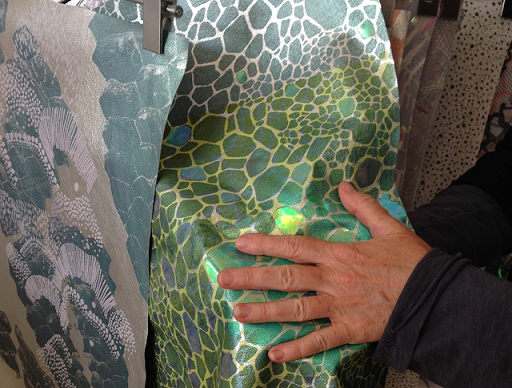
Rhianne Goldie
Inspired by Japanese meanings assigned to flowers, Emilie Dodds looks at native flowers and contemporizes the tasteful traditional theme of a floral motif, in a digitally printed collection for the commercial textile market. Her bouquet of delicate charcoal flowers exquisitely maintains its hand-drawn quality when translated into paper and fabric. Equally mesmerizing is the work of Rhianne Goldie, elaborately demonstrating her love of life and surfaces. When activated by heat, subtle or dramatic colour changes shift the patterns within the fabrics, akin to leather and iridescent, and reminiscent of lizard skin or fish scales.
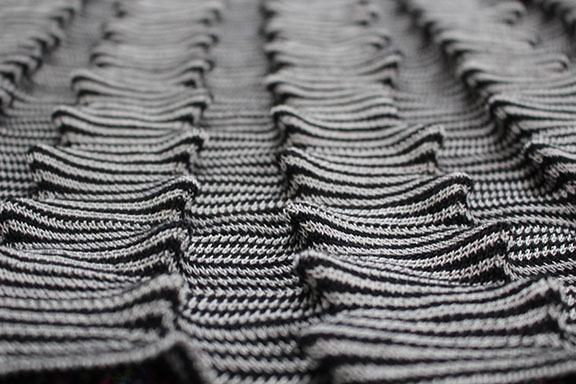
Rachel Lees
The menswear knit collection of Rachel Lees, right down to her business card, is about distorted repetition. Her design is comprised of systems of knitted loops in 3D printing which are derived from programming errors and computational mistakes. These glitches make zig-zags of black and white static, which invert between monochromatic and brighter colours through the use of glittery thread. Her work is at its most interesting when she picks up on these irregularities, playing with the idea of a new version of Herringbone for example, rather than the perhaps more decorative renditions of her design.
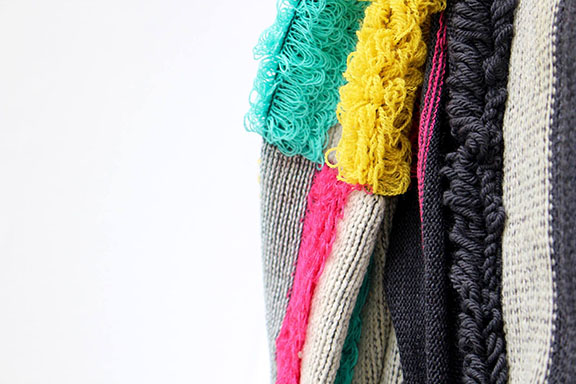
Abbie Neave
Who made your clothes? Abbie Neave has been busy answering this query by providing a collection of adaptable womenswear clothing. She offers playful, changeable components, whether it’s zipping on a new funky panel or swapping the bottom compartment of a skirt. Although this is modular wear, it cleverly allows for bright colour customization and individuality, even creating a remarkable, reversible knitted jacket using natural products of wool and linen. The life of the garment is extended through using natural products, and ultimately rendering the quality of life of both wearer and maker of the garment better.
This year’s show does not disappoint. A high standard of quality and craftsmanship is wonderfully demonstrated throughout, alongside impressive creative contexts and concepts for the pieces on display.
Jan Johnson

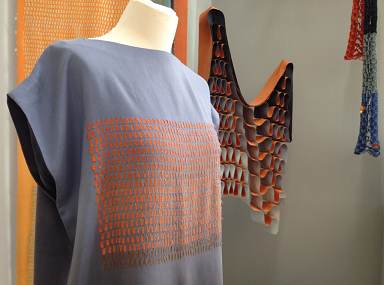
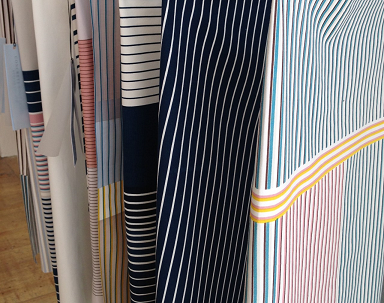

Leave a Reply